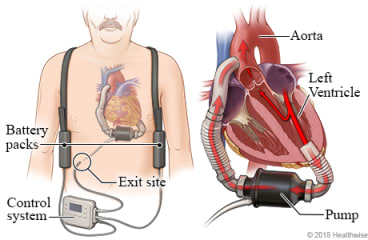Learning About Ventricular Assist Devices (VAD)
What is a ventricular assist device?

A ventricular assist device (VAD) helps pump blood from your heart to the rest of your body. It's used when
your heart is not able to pump enough blood on its own.
The device consists of a pump, tubes that connect the pump to the heart, a control system, and a power
source. A thin cable connects the pump with the control system. This cable, also called a lead or driveline,
comes out of your belly through a small cut in your skin called an exit site.
Your doctor may recommend that you get a VAD if:
-
You are waiting for a heart transplant.
-
Your heart needs long-term help to pump blood.
-
Your heart is healing from an injury or illness and it needs help until it can pump on its own.
VADs come in different shapes and sizes. You will receive the type of device that works best for your needs.
How is VAD surgery done?
During surgery, the doctor attaches the pump to the lower left chamber of the heart. A tube connects the pump
to the aorta. The aorta is the artery that sends blood from the heart to the body. The doctor may place the
pump inside or outside of your body.
If the pump is placed inside your body, the doctor will make a small cut in the skin of your belly. This cut
is called an exit site. The doctor places a thin cable through the cut. The cable connects the pump to the
control system. Other cables connect the control system to the battery packs. Most people carry the battery
packs and control system in a shoulder strap and belt.
How does a VAD work?
The device pulls blood from the heart and pumps it into the aorta. The aorta sends blood to the rest of the
body. Most of the blood that your heart would normally pump is pumped by the device instead.
Most of these devices can adjust to different levels of activity. For example, if you begin to walk, the
device increases how much blood it pumps. Your doctor will tell you if your device does this.
What can you expect after getting a VAD?
Your doctor will give you detailed instructions about how to care for your device. These will include how to
care for the exit site, where the cable comes out of your belly.
A team of specialists will help you with your device and your treatment plan. You'll have regular follow-up
visits to check your health and make sure your device is working well.
Most people with a VAD feel better and have a better quality of life. They can be active, be social, and
enjoy hobbies.
Having a VAD may cause problems like infection and blood clotting. However, the device can be lifesaving.
Your treatment team will help you know what you can do to help prevent problems.
Your doctor may prescribe several medicines for you. You may be taking some of them already. These medicines
will treat your heart and help you avoid problems with the device.
Some people decide to turn off the VAD near the end of life. Making this decision can be easier after you,
your doctor, and your loved ones have talked about what you can expect from your life now and in the future.
When you schedule your next doctor visit, ask if you can have time to talk about your end-of-life wishes.
Follow-up care is a key part of your treatment and safety. Be sure to make and go to all
appointments, and call your doctor if you are having problems. It's also a good idea to know your test results
and keep a list of the medicines you take.
Current as of: June 24, 2023
Content Version: 14.0
Care instructions adapted under license by your
healthcare professional. If you have questions about a medical condition or this instruction, always ask
your healthcare professional. Healthwise, Incorporated disclaims any warranty or liability for your use of
this information.